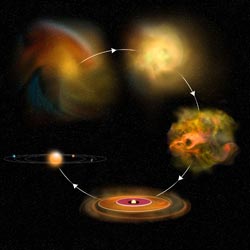Astronomers Get Rare Peek at Early Stage of Star Formation

New observations show 'pristine' example of second<br> stage of star formation shown in this graphic. <br>(Images not to scale.) CREDIT: Bill Saxton, NRAO/AUI/NSF<br>
The new observations promise to help scientists understand the early stages of a sequence of events through which a giant cloud of gas and dust collapses into dense cores that, in turn, form new stars.
The scientists studied a giant cloud about 770 light-years from Earth in the constellation Perseus. They used the European Space Agency's Herschel Space Observatory and the National Science Foundation's Green Bank Telescope (GBT) to make detailed observations of a clump, containing nearly 100 times the mass of the Sun, within that cloud.
Stars are formed, astronomers think, when such a cloud of gas and dust collapses gravitationally, first into clumps, then into dense cores, each of which can then begin to further collapse and form a young star. The details of how this happens are not well understood. One difficulty is that most regions where this process is underway already have formed stars nearby. Those stars affect subsequent nearby star formation through their stellar winds and shock waves when they explode as supernovae.
“We have found the first clear case of a clump of potentially star-forming gas that is on the verge of forming dense cores, and is unaffected by any nearby stars,” said James Di Francesco, of the University of Victoria, Canada.
“Finding such a 'pristine' clump of gas that may be starting to form dense cores is a key to gaining a fuller understanding of the early stages of star formation,” said Sarah Sadavoy, a graduate student also of the University of Victoria. “This is a rare find,” she added.
The far-infrared images from the Herschel Space Observatory were obtained as part of the Herschel Gould Belt Survey key program. They revealed previously-unseen substructures within the clump that may be precursors to cores with the potential to form individual stars. The astronomers used the GBT to study the motions and temperatures of molecules, primarily ammonia, within these substructures. These GBT observations indicated that one of the substructures is likely to be gravitationally bound and thus farther along the path to condensing into a core than the others.
“This may be the first observation ever of a core precursor,” DiFrancesco said.
The entire clump, the scientists say, could be expected to form about ten new stars.
“This region appears to be an excellent candidate for future core formation, and thus is an ideal area for additional studies that can help us understand how this process works without the triggering effect of winds from other stars and shocks from supernova explosions,” Sadavoy said.
The scientists will publish their results in the journal Astronomy & Astrophysics.
The National Radio Astronomy Observatory is a facility of the National Science Foundation, operated under cooperative agreement by Associated Universities, Inc.
Media Contact
More Information:
http://www.nrao.eduAll latest news from the category: Physics and Astronomy
This area deals with the fundamental laws and building blocks of nature and how they interact, the properties and the behavior of matter, and research into space and time and their structures.
innovations-report provides in-depth reports and articles on subjects such as astrophysics, laser technologies, nuclear, quantum, particle and solid-state physics, nanotechnologies, planetary research and findings (Mars, Venus) and developments related to the Hubble Telescope.
Newest articles

Properties of new materials for microchips
… can now be measured well. Reseachers of Delft University of Technology demonstrated measuring performance properties of ultrathin silicon membranes. Making ever smaller and more powerful chips requires new ultrathin…

Floating solar’s potential
… to support sustainable development by addressing climate, water, and energy goals holistically. A new study published this week in Nature Energy raises the potential for floating solar photovoltaics (FPV)…

Skyrmions move at record speeds
… a step towards the computing of the future. An international research team led by scientists from the CNRS1 has discovered that the magnetic nanobubbles2 known as skyrmions can be…





















